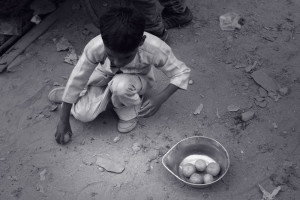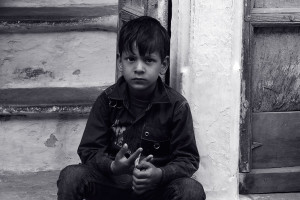 By Kate Wallace, 1/21/2015. I had an interesting Skype meeting with the Children’s Organization of South-East Asia today. They are based in Thailand, so not in India but I felt they did relevant work to some of the things I’ve started to look deeper into. I’ve become very interested in education as a means of fixing some of India’s social problems. There are so many kids here, and they could provide an educated skilled workforce ready to rebuild this company to benefit the native people, or they could be uneducated and impoverished, at risk for being exploited by foreigners and the upper class. Looking around me I think India is heading towards the latter. There are tons of kids coming up to me on the streets begging for money in the middle of the day, kids working on construction that I pass on my way to work, a young girl who works as a maid at the house I’m living at, etc. Some additional reading I did on the topic gave me different statistics for how many children complete school, I got everything from 60% to 90%. I started asking my Indian friends why this is, and they said lack of access and also human trafficking and child exploitation play a big role. So then this lead me to ask, who is most at risk for human trafficking? How does this occur? And what can a kid do to protect themselves?
By Kate Wallace, 1/21/2015. I had an interesting Skype meeting with the Children’s Organization of South-East Asia today. They are based in Thailand, so not in India but I felt they did relevant work to some of the things I’ve started to look deeper into. I’ve become very interested in education as a means of fixing some of India’s social problems. There are so many kids here, and they could provide an educated skilled workforce ready to rebuild this company to benefit the native people, or they could be uneducated and impoverished, at risk for being exploited by foreigners and the upper class. Looking around me I think India is heading towards the latter. There are tons of kids coming up to me on the streets begging for money in the middle of the day, kids working on construction that I pass on my way to work, a young girl who works as a maid at the house I’m living at, etc. Some additional reading I did on the topic gave me different statistics for how many children complete school, I got everything from 60% to 90%. I started asking my Indian friends why this is, and they said lack of access and also human trafficking and child exploitation play a big role. So then this lead me to ask, who is most at risk for human trafficking? How does this occur? And what can a kid do to protect themselves?
COSA does some pretty amazing work in Thailand. Their team uses the information previously outlined to identify at risk youth and they bring them to the shelter and give them education. They currently have 3 outreach programs, but each can only run when they have the right resources. One brings medical assistance to remote areas which is significant because people often live too far away to get access to a hospital, and even if they can get access they often can’t afford it. The second is sending a school bus into the rural and remote areas and bringing kids to school at the center, but this is dependent on funds and available teachers. The third is sending a Thai social worker into villages who finds high risk girls and brings them to the center. She works with the founder of the program, Mickey, and is in charge of identifying risk. There are other shelters with similar programs to COSA and theirs is relatively small, only able to house 35 girls at a time. There is more need than they can supply for. However their program offers a unique approach in targeting prevention as opposed to only intervention and recovery. Their founder is also interesting because he was born in Thailand and speaks both Thai and English fluently, but grew up in the U.S. Lani said he is able to walk the line between the two worlds which reminded me of what Kristin said in her interview about always being an outsider. Most of the other NGOs are run by complete foreigners.
To determine whether or not a child is high risk COSA looks at a certain profile:
1) Girls are more at risk than boys.
2) Poverty is one of the most significant factors, especially because it often affects a child’s ability to get an education and creates external pressures to work at a young age. Their levels and access to education also play a role, as if they are not in school they will be working and if they are working at a young age they will be exploited. Lani said even if they start by working at a restaurant at 14 then by 16/17 have opened themselves to other exploitation.
3) Citizenship and legal documents can affect their rights and access to education. The majority of girls they work with belong to hill tribes. A lot of ethnic minorities in Thailand emigrated from China in some cases or Myanmar or Laos or Cambodia, and either came illegally or never acquired the required documentation. This means they don’t have a passport or Thai ID card, which means they don’t have access to higher education and can never leave the country.
4) She said they always look at their family history, such as if there is a parent or sibling who is already a prostitute. If so the child is much more likely to also enter that line of business. Sexual abuse and substance abuse also play a role.
5) Their place of origin is a big factor. Traditionally speaking girls from hill tribes are more marginalized in north and north east Thailand. This was also noted in my interview with Kristin from Sew New Futures who said girls in rural and remote areas are most at risk. Access to education is related to the location of their homes because in some cases a child will have to travel many miles to get to school. Lani says in some cases it is amazing that kids continued to go to school for as long as they did, but eventually will give up because it is such a struggle.
Through my research I have found that there are a number of typical scenarios in which kids are vulnerable to human trafficking: kids are kidnapped from their homes, typically rural areas and brought to the city; kids are sold by their parents; kids are lured into an exploitative situation by family member or friend; kids willingly go in search of work to support their families and end up being exploited. Lani said that the horror stories of kidnapping don’t seem to be as much of a problem now and she doesn’t think any of the kids at the centre were kidnapped. However, she said this could just be because of their location, and perhaps in India in the cities I would get a different story. There are more instances of trafficking where people are agreeing to be shuttled from point a to point b (i.e. hill tribes in Thailand to Bangkok) when they get there found out the job is really something else than they’ve been promised, such as a domestic slave vs. house maid.
We had an interesting discussion about what kids can do to protect themselves from human trafficking, and from it I came up with this list:
1. Never surrender your passport or identification
2. Make sure you can read the job contract
– Problem with this is if they give you one in English and one in another language, the English one might be different
3. Go directly through the employer instead of through a middleman
4. Ask to speak to a person or see a picture
– Both 3 and 4 could be falsified by trafficker
5. Have a backup plan. Is there a relative you could reach out to or an organization you have the phone number of to help you if you need it? Do you have extra money?
6. Know what resources you can reach out to, especially if you are there illegally
7. Know your rights. For example, if you have debt, it doesn’t mean you have to work as slave labour to pay it off.
8. The minimum working age is 14. If you are under that age you will most likely be exploited.
Our conversation lead to talking about girls in villages. She said a huge problem in this culture is girls are not viewed to be as valuable as boys, and can be killed after they are born. You go to villages and there are no girls in a certain age range. This causes problems when boys have to get married, and sometimes in these cases they will kidnap girls from other villages.
All in all this was a very enlightening and informative interview. COSA has agreed to support me during my project and I look forward to working more with them in the future.
